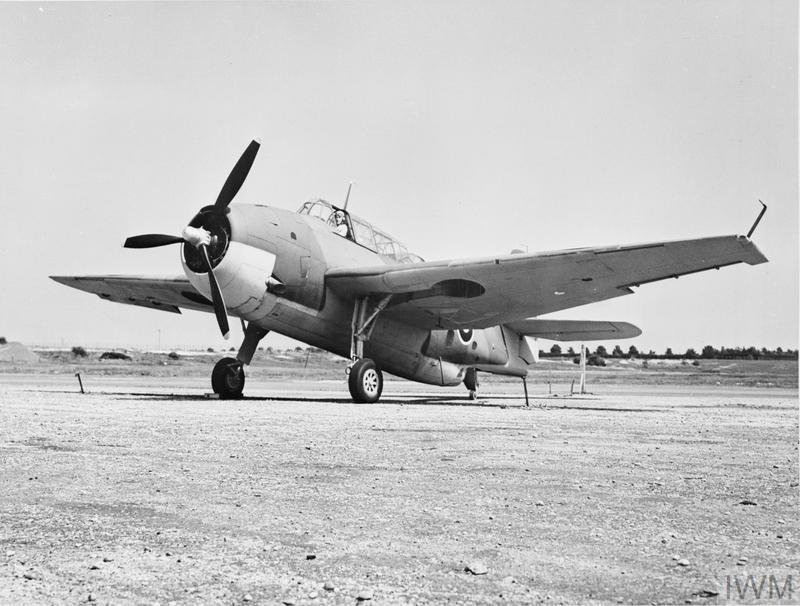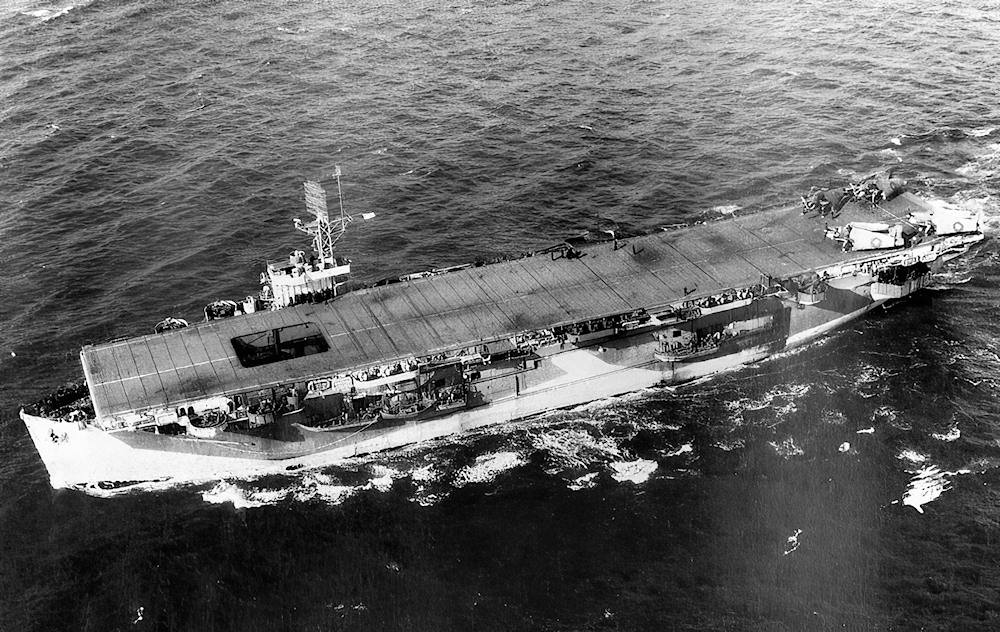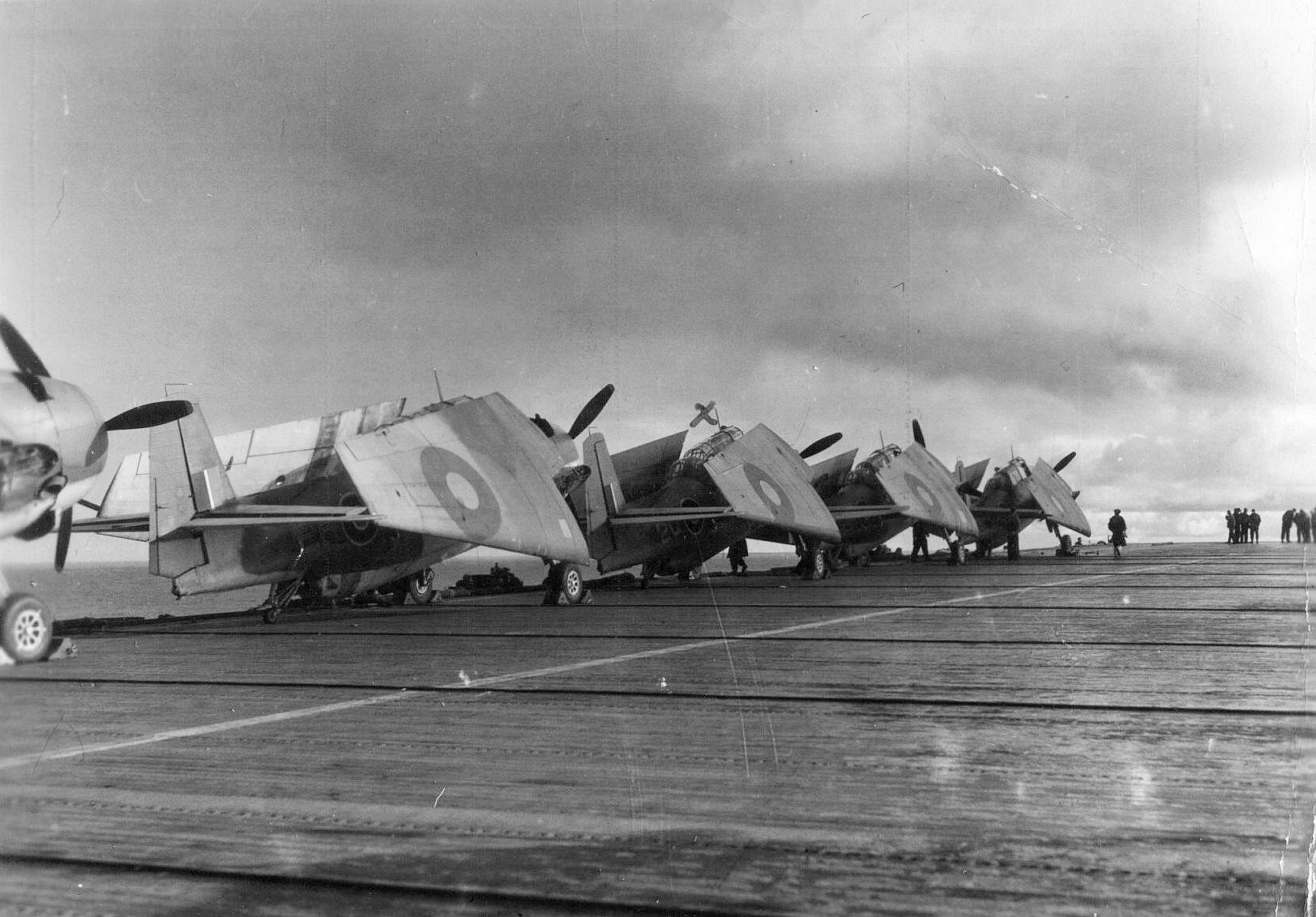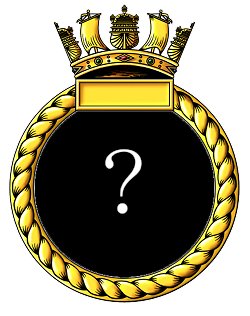



The Squadron was formed in the United Sates on November 1st 1943 at the US Naval Air Station Squantum, Massachusetts under the command of Lt Cdr (A) R. E. Bradshaw DSC, RN. The squadron was issued with twelve Tarpon Is.[1] The flying personnel were organised to form thirteen crews, twelve being assigned their own aircraft with one a spare crew.
Few of the squadron officers had previous squadron experience, the others were pilots who had just completed their training with the US Navy at Pensacola and Fort Lauderdale, and observers who had recently finished their training at RNAS Piarco, Trinidad. The squadron complement also included 13 Telegraphist-Air-Gunners and a ground staff of 107 Petty Officers and ratings.

The Grumman Avenger Mk.1 - known as the 'Tarpon' in the RN - as issued to 852 squadron at Squantum. © IWM A 19796
After familiarisation with the aircraft and equipment the squadron began training in earnest to prepare for active service. The 12-week work-up period embraced all the many aspects of the work of torpedo bomber reconnaissance squadrons and included navigation exercises, low flying, formation flying and combat tactics, torpedo and depth charge attack techniques.
There were five flying incidents during their time at Squantum; the first was on November 22nd, while avoiding another aircraft on the runway Sub-Lt. P. Westover RNVR swung his aircraft, JZ161 ('2H') to the edge of the runway but braked too hard and the aircraft ended on its nose. On December 1st the undercarriage of JZ158 ('2A'), flown by Sub-Lt. I. S Watson RNZNVR, collapsed on landing. On the 8th Sub-Lt. I. P. Davis RNVR in JZ156 ('2W), turned down the wrong runway and crashed into another aircraft, the crew were unhurt. On December 21st Sub-Lt. D. Cash RNVR in JZ159 ('2F') ground looped landing in a cross wind. The final incident was during night-flying on January 24th 1944, Sub-Lt. L. P. Weston flying in JZ161 ('2H') was struck from behind by a US navy SBD landing behind it at Squantum smashing the tail assembly.
At the end of the work-up the squadron prepared for a cross-country trip, Squantum to Alameda, San Francisco in preparation for joining a new escort carrier which was due to sail from Vancouver in early February. A ground party travelled by train with the squadron equipment and stores. The flight to San Francisco started on February 2nd 1944 and was done in several legs; Squantum, Massachusetts to Lynchburg, Virginia; Lynchburg to Shreveport, Louisiana; Shreveport to El Paso, Texas; El Paso to Tucson, Arizona. Tucson to San Francisco.
There is only one recorded incident during this journey, while landing at Lynchburg, Virginia later on the 2nd, JZ167 ('2R') flown by Sub-Lt K. R. Stevens RNZNVR was caught in the slipstream of the aircraft ahead and veered off the runway striking a low bank damaging the prop and starboard wing. The remaining 11 aircraft continued on while Lt. Stevens and his crew awaited repairs.
The squadron had flown across the USA to join the new escort carrier HMS NABOB at the earliest possible stage of her maiden voyage. NABOB sailed from Vancouver on February 6th after completing a period of modification and alteration to bring the Seattle built ship up to Admiralty standards. NABOB secured alongside at pier 7 at US Naval Air Station Alameda in San Francisco Bay on February 10th. The 11 aircraft that continued on from Lynchburg also arrived at Alameda on the 10th; Sub-Lt Stevens and his crew arrived on the 11th. The Squadron were embarked by crane on the 11th.

HMS NABOB with 852 Avengers embarked, March 1944.
NABOB and the squadron sailed for San Diego on the 15th. Flying operations commenced the next day; Sub-Lt. W. L. Black RNVR flying JZ159 ('2F’) had the squadron’s first barrier crash, damaging the propeller and cowling; also, on the 16th the squadron lost its first aircraft, ('2N’) flown by Sub-Lt Batten RNVR it failed to gain height after take off and ditched just off the bow. The ship was being escorted by US Navy Blimp K-115 and the crew immediately dove down and dropped an inflated dingy alongside, Sub-Lt Batten walked along the wing, stepped into the dingy and was picked up by motor launch from the plane guard destroyer USS BALLARD. He was returned to NABOB, rescued unhurt and without even getting his feet wet. On the 17th Sub-Lt K. R. Stevens RNZNVR flying JZ157 ('2C') landed with his arrester hook up and entered the barrier, coming to rest on its nose. On completion of flying the ship arrived at San Diego.
NABOB arrived at the U.S. Naval Dockyard Norfolk, Virginia on March 8th to be dry docked for a propeller change. Unserviceable aircraft were put ashore on the 12th and replacements embarked by lighter. She sailed from Norfolk on the 18th and secured at a quayside at Staten Island, New York on March 19th. Here the Avengers of 852 were stowed in the hangar and NABOB embarked a ferry cargo of 45 P51 Mustangs for delivery to the RAF.
On completion of loading NABOB sailed from New York on March 23rd, joining the fast troop convoy UT.10 bound for Greenock. NABOB detached from the convoy off Ireland and docked at Gladstone Dock, Liverpool on April 5th and unloaded her cargo of Mustangs to RAF Speke, before continuing on to the Clyde; the aircraft of 852 squadron were flown off to RNAS Machrihanish on April 7th; NABOB then proceeded to enter a dockyard for repairs.
At RNAS Machrihanish flying training resumed. At the end of May the squadron mourned the loss of the crew of FN867 ('2K'), Sub-Lt. R. B. Lord RNVR, Sub-Lt. R. T .J. Thwaites RNVR and Leading Airman A. G. Winder, who together with a passenger Naval Air Mechanic (L) E. W. Gallant, were killed when the aircraft flew into a hillside in low cloud and bad weather 2 miles NW of Carradale, Mull of Kintyre.
At the end of June, a fighter flight of 4 Wildcat Vs was added to the squadron bringing the strength up to 16 aircraft; this flight had been formed at RNAS Eglinton, Northern Ireland and embarked in NABOB on June 26th when the Avengers re-embarked from RNAS Machrihanish to begin working up with the ship off Belfast. The departure from Machrihanish was not without incident; one aircraft, FN804 ('2H’) was unable to lower its undercarriage and had to return to the airfield where it landed safely ashore. Sub-Lt. L. S Watson RNZNVR landed on in JZ165 ('2P’) caught No.2 wire and skidded to port, the port wheel ran off the edge of the deck and into the catwalk. A taxiing mishap occurred when the prop of JZ163 ('2L’) hit the starboard elevator of JZ164 ('2M') damaging both aircraft.

The Avengers of 852 squadron parked on the deck of HMS NABOB.
The intensive flying work-up continued until July 8th. The only other flying incidents occurred on June 29th; Sub-Lt F. .M Batten RNZNVR in JZ164 ('2M') came in a little high and ran into the barrier which was unable to prevent it colliding with ('2G’) just forward of the barrier chewing off its tail and starboard wing, but causing only superficial damage to '2M' including a bent prop and damaged wing. Later while spreading wings ready for take-off the starboard wing of JZ272 ('2A') was caught in the arc of the prop of JZ249 (‘2R') tearing a large hole in the wing, and damaged the prop of ‘2R')'.
With the flying element of NABOB s work up completed 852 squadron disembarked to RNAS Abbotsinch on July 8th to re-equip with replacement aircraft, returning to RNAS Machrihanish on the 12th. On the 14th they re-embarked in NABOB to begin preparing for anti-shipping and mine laying operations to be conducted off the coast of Norway.
One of the new aircraft was put out of service during the embarkation; FN908 (''2O') flown by Lt. Cdr R. E. Bradshaw was another victim of the failing arrestor hook, his broke off and the aircraft entered the barrier damaging the prop & engine. Sub-Lt. M. E. R. Keates RNVR recorded the first Wildcat incident on the same date in JV 355, landing heavily on the port wheel causing minor damage. During the preparation for the operation there were two more barrier crashes, both involving Sub-Lt. D. Cash RNVR; on July 21st in FN898 ('2C') he crashed into the barrier due to the arrestor hook giving way on landing causing damage to the prop and undercarriage. The following day flying in FN806 ('2H') a similar incident happened when the arrester hook struck the rounddown and broke, the aircraft crashed into the barrier damaging the engine, prop and undercarriage; this aircraft was put ashore on July 26th and a replacement, FN875 was hoisted aboard on the 28th. A second Wildcat landing incident occurred on July 30th when JV536 ('S') flown by Sub-Lt W. P. Hughes RNZNVR caught No. 2 wire which parted and the aircraft pulled to port causing the tail oleo to collapse and wrinkled the fuselage.
From August 1st 1944 HMS NABOB was loaned to the Home Fleet and she proceeded to the anchorage at Scapa Flow. The squadron strength was increased to 13 Avengers and 6 Wildcats for this operation.
On August 10th NABOB operated with the fleet carrier INDEFATIGABLE and sister CVE TRUMPETER in Operation 'OFFSPRING'. This was an operation laying aerial mines in Haarhamsfjord and Lepsorev. On reaching the operational area on the 11th of August, NABOB launched two Wildcats as combat air patrol (CAP) over the fleet. Beginning at 1300 the 12 Avengers of 852 squadron, carrying a mine apiece, were launched; these formed up with another 12 from 846 squadron from TRUMPETER. Fighter protection was provided by Seafires, Fireflies and Hellcats from INDEFATIGABLE.
All the mines were laid without loss. The strike force arrived back over the ship as one of the escorting destroyers was attacking the enemy ahead of NABOB . The returning planes had to circle the carrier until she could resume the landing-on course. Once the aircraft had touched down, they were checked, refueled and rearmed in preparation for a second strike. Launch time for the second strike was 1815; this time the enemy was prepared but all mines were successfully placed and the force was back over the carriers by 1945. One Avenger from 846 squadron was lost. This was the largest aircraft mine laying operation by elements of the Home Fleet, 47 mines were successfully laid by the Avenger crews. 'OFFSPRING' also saw fighter aircraft attacking ground targets, a WT station on Vigra Island and 6 Bf-110 aircraft on the ground at Gossen airfield were strafed and destroyed, and sunk a 90-ton minesweeper, R-89.: 1 Firefly and 3 Seafires of the fighter escort were lost. The extra Avenger embarked with 852 did not participate, it was armed and ready but did not launch.
The Force withdrew to regroup, NABOB and TRUMPETER proceeded to Rosyth to embark more mines in preparation for the next operation. Avenger FN896 ('2P') flown by Sub-Lt L. S Watson RNZNVR caught a late wire landing on the 12th and entered the barrier.

The aircrew briefing room on board HMS NABOB, squadron pilots and observers gathered for a pre-flight briefing.
Operation 'GOODWOOD' was a three-stage series of strikes against the German Battle Ship TIRPITZ to take place between the 21st and 28th of August 1944. This operation was to see 247 sorties of Barracudas, Hellcats and Corsairs launched from four carriers, VICTORIOUS, FURIOUS, TRUMPETER and STRIKER. NABOB and 852 were tasked with providing anti-submarine cover for the task force. For this operation NABOB embarked an additional three Avengers from 856 naval air squadron from RNAS Eglinton, Northern Ireland on the 18th.
Due to bad weather over the target area the H-hour for Operation GOODWOOD had been delayed and it was decided that the Avengers would not participate in the first strike. NABOB launched her four Wildcats at 12:25 for CAP sorties, one made a successful emergency landing at 14:32, the remaining three Wildcats were landed on at 15:04. At 15p30 KENT, TRUMPETER, NABOB and the 5th escort group were detached to the westward. NABOB was instructed to fuel three destroyer escorts commencing at 18:00 and TRUMPETER was to provide patrols and strikes. The flight deck was being cleared of aircraft and the hands were laying out the fuelling hose.
At 17:15 NABOB was struck by a single acoustic torpedo fired by U-354 which struck her on the starboard side, causing a 32-square foot hole abaft the engine room, below the waterline. She began to take on water at an alarming rate; within minutes NABOB was listing to Starboard and was 15 feet down by the stern. All electrical power had been lost and NABOB was dead in the water. A second torpedo was launched which struck HMS BICKERTON at 17:23, she quickly sank.
The Canadian escort HMCS ALGONQUIN took 205 men off the carrier to lighten the ship as the damage control parties worked to shore up the hole and stem the flooding. It was some time before power was restored and the ship was able to make way under her own steam, three knots being the maximum speed she could safely make. The U-Boat was still a threat and it was decided to attempt to launch an Avenger to deter it form getting in too close. At 0230 on the 23rd Lt. Cdr Bradshaw and his crew were successfully accelerated off the sloping deck in FN875 ('2H'), this was followed by a second Avenger piloted by Sub-Lt D. G. Jupp RNVR. The two aircraft successfully thwarted the submarine during their 4-hour patrol. On returning to the carrier the weather reduced visibility on the approach to the sloping and listing deck; Sub-Lt Jupp managed to safely land on first but Lt. Cdr Bradshaw was not so lucky, his aircraft missed the arrestor wires and snagged the barrier bringing it down into the aircraft park on top of JZ249 ('2F') causing major damage, also damaging Avenger FN887 ('2L') & Wildcats ‘D’ &’N’. The aircraft guns fired on impact and its depth charges broke free and rolled down the deck, they were stopped before they could go over the side and sink NABOB. On clearing the wreckage Avengers '2H' & '2F' were jettisoned as beyond repair and the remaining aircraft were secured.

HMS NABOB dead in the water, listing to starboard and down by the stern after being torpedoed August 22nd 1944, five Avengers are still on the sloping deck and two would later be launched to deter a shadowing U-Boat.
NABOB arrived at Scapa Flow on August 27th to undergo emergency repairs; the Avengers of 825 were put ashore to RNAS Hatston on this date, the Wildcats followed on September 1st. The squadron would not return to NABOB, she was damaged beyond economical repair and would see no further service; 21 men were killed, including 6 from 852 squadron, and a further 6 injured in the attack.
The squadron was now based out of
RNAS Hatston, and a number
of personnel were reassigned to other squadrons. On
September 11th the 12 Avengers and 4 Wildcats embarked in
TRUMPETER together with the aircraft of 846 squadron for further aerial minelaying
operations.
Operation
BEGONIA: The force comprised of the Fleet carrier FURIOUS, on her final operational mission, H. M. Cruiser DEVONSHIRE, Destroyers MYNGS, MARNE, MUSKETEER, VIGILANT, VERULAM, and HMCS ALGONQUIN. Mines were laid south of Vosko Island on the 12th, the forces returned to Scapa on the 13th. On arrival 852 disembarked to
RNAS Hatston. Two squadron aircraft were damaged during the operation both by flak; Avenger JZ272 ('2A') flown by the squadron C.O. Lt. Cdr R. E. Bradshaw was damaged by flak causing the undercarriage to collapse on landing back on, and Wildcat JV650 ('2H') flown by Sub-Lt W. J. Kurney RNZNVR had a large hole punched in his starboard
aileron during an attack on shipping, he landed on
TRUMPETER safely.
Operation 'TENABLE': A detachment of 4 Avengers was embarked in TRUMPETER on September 23rd and the 4 Wildcats in FENCER on the 27th in preparation for Operation TENABLE, aerial minelaying in in Ramisoysund, Lepsoyrev, and Harhamsfjord. The force comprising H.M cruiser EURYALUS, CVEs FENCER & TRUMPETER, Destroyers CASSANDRA, CAPRICE, MYNGS, CAMBRIAN, ZAMBESI, & SAVAGE, left Scapa on the 28th. They reached the operational area, but the operation was eventually abandoned owing to continuing bad weather; the force arrived back at Scapa on October 5th. Both detachments disembarked to RNAS Hatston, the Wildcats on the 7th, the Avengers on the 8th.
Operation 'LYCIDAS': Elements of the squadron re-embarked in FENCER on the 10th and TRUMPETER on the 12th for Operation LYCIDAS, a repeat of the abandoned Operation TENABLE mining in Lepsoyrev, Ramsoyund, and Harhamsfiord (presumably 3 Avengers in TRUMPETER and 4 Wildcats in FENCER). The force left Scapa on the 13th and on October 15th the Avengers laid mines off Åramsund and Sado as a result of a navigational error. Mines were also sown in the designated area during the following day.
One day out from Scapa Avenger JZ166 ('2Q') flown by Sub-Lt I. P. Davis RNZNVR suffered starboard wing damaged landing on TRUMPETER, on the 15th Sub-Lt L. Dunbar RNVR made a flapless landing in FN8I4 ('2R') and entered the barrier on TRUMPETER. The last recorded incident was on October 16th when FN887; ('2L'), operating from FENCER dropped its starboard wing on take-off and dove into the sea; the crew Sub-Lt L. S. Watson RNZNVR, Sub-Lt E. Brimelow RNVR & PO W. Aitken were picked up by the destroyer SCORPION.
The force arrived back at Scapa on the 17th and 852 squadron was officially disbanded on arrival at RNAS Hatston.

NORWAY 1944
Lt. Cdr (A) (P) R. E. Bradshaw DSC, RN 01 Nov 1943
Squadron disbanded 17October 1944
None
© 1999-2025 The Royal Navy Research Archive All Rights Reserved Terms of use Powered byW3.CSS
Press F5 to refresh the page after posting your comment or to hide the form
The first American built aircraft to enter RN service were the Grumman Avenger and Wildcat but the Admiralty changed their names to Tarpon and Martlet respectively. The name 'Tarpon’ was used for the Avenger Mk I and II, while ‘Martlet’ was used for Wildcat Mk I to IV; from January 1944 the Admiralty reverted to use the American names of Avenger from Mk III and Wildcat from Mk V to avoid confusion.
Close
Comments (0)